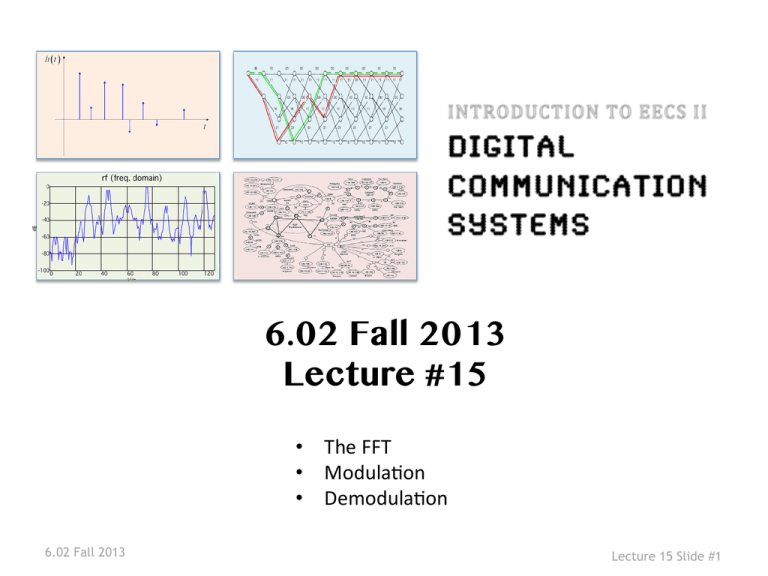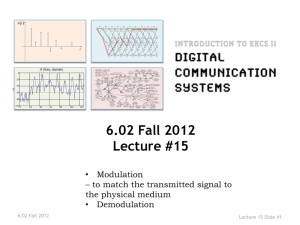N - MIT
advertisement

6.02 Fall 2013
Lecture #15
• The FFT • Modula,on • Demodula,on 6.02 Fall 2013
Lecture 15 Slide #1
DT Fourier Transform (DTFT) for
Spectral Representation of General x[n]
1
x[n] =
2π
∫
X(Ω)e
jΩn
dΩ
where
X(Ω) = ∑ x[m]e− jΩm
<2 π >
m
This Fourier representation expresses x[n] as
jΩn
a weighted combination of e
for all Ω in [–π,π].
X(Ωο)dΩ is the spectral content of x[n]
in the frequency interval [Ωο, Ωο+ dΩ ]
6.02 Fall 2013
Lecture 15 Slide #2
Fast Fourier Transform (FFT) to compute
samples of the DTFT for
signals of finite duration
(P/2)−1
P−1
X(Ωk ) = ∑ x[m]e
m=0
− jΩk m
,
1
jΩk n
x[n] =
X(Ω
)
e
∑
k
P k=−P/2
where Ωk = k(2π/P), P is some integer (preferably a power of 2) such
that P ≥ L, where [0,L-1] is the time interval outside of which x[n] is
zero, and k ranges from –P/2 to (P/2)–1 (for even P).
Computing these sums directly involves O(P2) operations – when P
gets large, the computations get very s l o w….
Happily, in 1965 Cooley and Tukey published a fast (divide-andconquer) method for computing the Fourier transform (aka FFT,
IFFT), rediscovering a technique known to Gauss. This method
takes O(P log P) operations.
6.02 Fall 2013
P = 1024, P2 = 1,048,576, P logP ≈ 10,240
Lecture 15 Slide #3
Where do the Ωk live?
e.g., for P=6 (even)
Ω-3
Ω-2
Ω-1
Ω2
Ω1
0
–π
exp(jΩ2)
exp(jΩ3)
= exp(jΩ-3)
–1
exp(jΩ-2)
6.02 Fall 2013
Ω0
j
.
–j
Ω3
π
exp(jΩ1)
1
exp(jΩ0)
exp(jΩ-1)
Lecture 15 Slide #4
Input/Output Behavior of
LTI System in Frequency Domain
1
x[n] =
2π
∫
X(Ω)e
jΩn
<2 π >
dΩ
H(Ω)
1
y[n] =
2π
∫
H (Ω)X(Ω)e jΩn dΩ
<2 π >
1
y[n] =
2π
∫
Y (Ω)e jΩn dΩ
<2 π >
Y (Ω) = H (Ω)X(Ω)
Spectral content
of output
Frequency response
of system
6.02 Fall 2013
Spectral content
of input
Lecture 15 Slide #5
http://www.pcmag.com/article2/0,2817,1769243,00.asp
6.02 Fall 2013
Lecture 15 Slide #6
Phase of the frequency response
is important too!
• Maybe not if we are only interested in audio, because the ear is not so sensi,ve to phase distor,ons • But it’s certainly important if we are using an audio channel to transmit non-­‐audio signals such as digital signals represen,ng 1’s and 0’s, not intended for the ear 6.02 Fall 2013
Lecture 15 Slide #7
To gauge how it will fare on lowpass and bandpass channels, let’s look at the spectral content of a rectangular pulse, x[n]=u[n]-­‐u[n-­‐256], of the kind we’ve been using in on-­‐off signaling in our Audiocom lab. Any guesses as to spectral shape? n 6.02 Fall 2013
Lecture 15 Slide #8
Derivation of DTFT for rectangular pulse
x[m]=u[m]-u[m-N]
N−1
X(Ω) = ∑ x[m]e
− jΩm
m=0
= 1+ e
− jΩ
= (1− e
+e
− jΩN
− j 2Ω
+…+ e
− jΩ( N−1)
− jΩ
) / (1− e )
− jΩ( N−1)/2 sin(ΩN / 2)
=e
sin(Ω / 2)
Height N at the origin, first zero-­‐crossing at 2π/N ShiOing in ,me only changes the phase term in front. If the rectangular pulse is centered at 0, this term is 1. 6.02 Fall 2013
Lecture 15 Slide #9
DTFT of x[n] = u[n+5] – u[n-­‐6] (centered rectangular pulse of length 11) N
-π
A periodic sinc
(or “Dirichlet kernel”)
– not the sinc we’ve
seen before!
2π/N
π
Ω
https://ccrma.stanford.edu/~jos/sasp/Rectangular_Window.html
6.02 Fall 2013
Lecture 15 Slide #10
Magnitude of preceding DTFT -π
Ω
https://ccrma.stanford.edu/~jos/sasp/Rectangular_Window.html
6.02 Fall 2013
Lecture 15 Slide #11
π
DTFT of x[n]= u[n] – u[n-­‐10], rectangular pulse of length 10 star,ng at ,me 0 Ω/2π
Ω/2π
6.02 Fall 2013
http://cnx.org/content/m0524/latest/
Lecture 15 Slide #12
Back to our Audiocom lab example
6.02 Fall 2013
Lecture 15 Slide #13
x[n]=u[n]-­‐u[n-­‐256] n 6.02 Fall 2013
Lecture 15 Slide #14
|DTFT| of x[n]=u[n]-­‐u[n-­‐256], rectangular pulse of length 256: 48000 samples of
|DTFT| spread
evenly between
[–π , π], computed
using FFT (around
3000 times faster
than direct
computation in this
case!)
If sampling rate is
48 kHz, then this
is 24,000 Hz
–π
6.02 Fall 2013
0 rads/sample
0 Hz
Ω = π
f = fs /2
Lecture 15 Slide #15
Zooming in on : |DTFT| of x[n]=u[n]-­‐u[n-­‐256] 256 = N Too much of the signal’s energy misses the loudspeaker’s passband! 0 6.02 Fall 2013
187.5 Hz (corresponds to 2π/N when fs = 48 kHz) Ω
Lecture 15 Slide #16
What if we sent this pulse through an
ideal lowpass channel?
|DTFT| of y[n], obtained by lowpass filtering x[n]=u[n]-­‐u[n-­‐256], cutoff 400 Hz –π
6.02 Fall 2013
0
Ω = π
f = fs /2
Lecture 15 Slide #17
Zooming in on |DTFT| of y[n], obtained by lowpass filtering of x[n]=u[n]-­‐u[n-­‐256], cutoff 400 Hz 256 = N
400 Hz
0
6.02 Fall 2013
Ω fS /(2π)
Lecture 15 Slide #18
Corresponding output pulse y[n], obtained by lowpass filtering the rectangular pulse x[n] No longer confined to its 256-­‐sample slot, so causes “intersymbol interference” (ISI). n
6.02 Fall 2013
Lecture 15 Slide #19
Effect of Low-Pass Channel
6.02 Fall 2013
Lecture 15 Slide #20
How Low Can We Go?
6.02 Fall 2013
Lecture 15 Slide #21
Complementary/dual behavior in
time and frequency domains
• Wider in ,me, narrower in frequency; and vice versa. – This is actually the basis of the uncertainty principle in physics! • Smoother in ,me, sharper in frequency; and vice versa • Rectangular pulse in ,me is a (periodic) sinc in frequency, while rectangular pulse in frequency is a sinc in ,me; etc. 6.02 Fall 2013
Lecture 15 Slide #22
A shaped pulse x’[n] versus a rectangular pulse x[n] Slightly round the transi,ons from 0 to 1, and from 1 to 0, by making them sinusoidal, just 30 samples on each end. 6.02 Fall 2013
n
Lecture 15 Slide #23
In the spectral domain: |DTFT| of rectangular pulse x[n] –|DTFT| of shaped pulse x’[n] 6.02 Fall 2013
Frequency content of shaped pulse only extends to here, around 1500 Hz Ω f /(2π)
Lecture 15 Slide
S #24
AOer passing the two pulses through a 400 Hz cutoff lowpass filter: The lowpass filtered shaped pulse y’[n] conforms more ,ghtly to the 256-­‐sample slot, and sejles a lijle quicker than y[n] n
6.02 Fall 2013
Lecture 15 Slide #25
But loudspeakers are bandpass,
not lowpass
6.02 Fall 2013
Lecture 15 Slide #26
http://www.pcmag.com/article2/0,2817,1769243,00.asp
6.02 Fall 2013
Lecture 15 Slide #27
|DTFT| of rectangular pulse x[n] aOer ideal bandpass filtering, 100 Hz to 10,000 Hz 10,000 Hz
0
6.02 Fall 2013
Ω fS /(2π)
Lecture 15 Slide #28
Zooming in: 10,000 Hz
0
6.02 Fall 2013
100 Hz
Ω fS /(2π)
Lecture 15 Slide #29
Corresponding pulse in ,me, i.e., bandpass filtered version of rectangular pulse x[n] Won’t do at all!! n
6.02 Fall 2013
Lecture 15 Slide #30
The Solution: Modulation
• ShiO the spectrum of the signal x[n] into the loudspeaker’s passband by modula3on! x[n]cos(Ωc n) = 0.5x[n](e
jΩc n
+e
− jΩc n
)
0.5
=
[ ∫ X(Ω')e j (Ω'+Ωc )n dΩ'+ ∫ X(Ω")e j (Ω"−Ωc )n dΩ"]
2π <2 π >
<2 π >
0.5
=
[ ∫ X(Ω − Ωc )e jΩn dΩ + ∫ X(Ω + Ωc )e jΩn dΩ]
2π <2 π >
<2 π >
Spectrum of modulated signal comprises half-height
replications of X(Ω) centered as ±Ωc (i.e., plus and minus the carrier frequency). So choose carrier frequency comfortably in the passband, leaving room around it for the spectrum of x[n]. 6.02 Fall 2013
Lecture 15 Slide #31
Is Modulation Linear? Time-Invariant?
x[n]
×
t[n]
cos(Ωcn)
… as a system that takes input x[n] and produces output t[n] for transmission? Yes, linear! No, not ,me-­‐invariant! 6.02 Fall 2013
Lecture 15 Slide #32
So for our rectangular pulse example: Time domain: pulse x[n] modulated onto 1000 Hz carrier 6.02 Fall 2013
n
Lecture 15 Slide #33
Corresponding spectrum of signal modulated onto carrier 0
6.02 Fall 2013
Lecture 15 Slide #34
Zooming in: 128, i.e.
half height
of original
10,000 Hz, upper
cutoff of bandpass
filter
–1000 Hz
1000 Hz
Ω fS /(2π)
0
6.02 Fall 2013
100 Hz, lower cutoff
of bandpass filter
Lecture 15 Slide #35
Pulse modulated onto 1000 Hz carrier makes it through the bandpass channel with very lijle distor,on n
6.02 Fall 2013
Lecture 15 Slide #36
At the Receiver: Demodulation
• In principle, this is (as easy as) modula,on again: If the received signal is r[n] = x[n]cos(Ωcn),
then simply compute d[n] = r[n]cos(Ωcn) = x[n]cos2(Ωcn) = 0.5 {x[n] + x[n]cos(2Ωcn)} • What does the spectrum of d[n] look like? • What constraint on the bandwidth of x[n] is needed for perfect recovery of x[n] by lowpass filtering of d[n]? 6.02 Fall 2013
Lecture 15 Slide #37




![[ ] [ ] ( )](http://s2.studylib.net/store/data/011910597_1-a3eef2b7e8a588bc8a51e394ff0b5e0e-300x300.png)